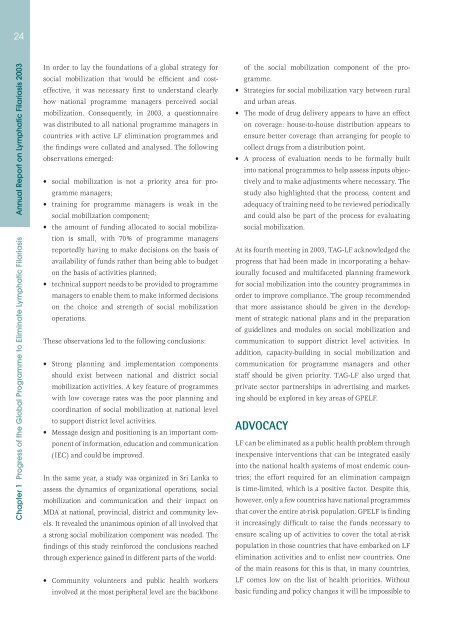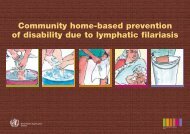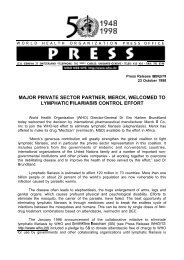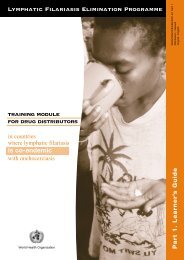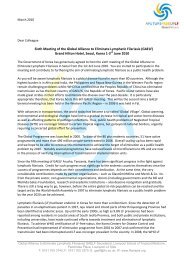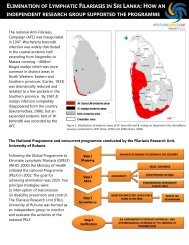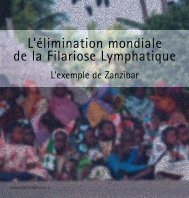Global Programme to Eliminate Lymphatic Filariasis ... - libdoc.who.int
Global Programme to Eliminate Lymphatic Filariasis ... - libdoc.who.int
Global Programme to Eliminate Lymphatic Filariasis ... - libdoc.who.int
Create successful ePaper yourself
Turn your PDF publications into a flip-book with our unique Google optimized e-Paper software.
24Annual Report on <strong>Lymphatic</strong> <strong>Filariasis</strong> 2003Chapter 1 Progress of the <strong>Global</strong> <strong>Programme</strong> <strong>to</strong> <strong>Eliminate</strong> <strong>Lymphatic</strong> <strong>Filariasis</strong>In order <strong>to</strong> lay the foundations of a global strategy forsocial mobilization that would be efficient and costeffective,it was necessary first <strong>to</strong> understand clearlyhow national programme managers perceived socialmobilization. Consequently, in 2003, a questionnairewas distributed <strong>to</strong> all national programme managers incountries with active LF elimination programmes andthe findings were collated and analysed. The followingobservations emerged:• social mobilization is not a priority area for programmemanagers;• training for programme managers is weak in thesocial mobilization component;• the amount of funding allocated <strong>to</strong> social mobilizationis small, with 70% of programme managersreportedly having <strong>to</strong> make decisions on the basis ofavailability of funds rather than being able <strong>to</strong> budge<strong>to</strong>n the basis of activities planned;• technical support needs <strong>to</strong> be provided <strong>to</strong> programmemanagers <strong>to</strong> enable them <strong>to</strong> make informed decisionson the choice and strength of social mobilizationoperations.These observations led <strong>to</strong> the following conclusions:• Strong planning and implementation componentsshould exist between national and district socialmobilization activities. A key feature of programmeswith low coverage rates was the poor planning andcoordination of social mobilization at national level<strong>to</strong> support district level activities.• Message design and positioning is an important componen<strong>to</strong>f information, education and communication(IEC) and could be improved.In the same year, a study was organized in Sri Lanka <strong>to</strong>assess the dynamics of organizational operations, socialmobilization and communication and their impact onMDA at national, provincial, district and community levels.It revealed the unanimous opinion of all involved thata strong social mobilization component was needed. Thefindings of this study reinforced the conclusions reachedthrough experience gained in different parts of the world:• Community volunteers and public health workersinvolved at the most peripheral level are the backboneof the social mobilization component of the programme.• Strategies for social mobilization vary between ruraland urban areas.• The mode of drug delivery appears <strong>to</strong> have an effec<strong>to</strong>n coverage: house-<strong>to</strong>-house distribution appears <strong>to</strong>ensure better coverage than arranging for people <strong>to</strong>collect drugs from a distribution po<strong>int</strong>.• A process of evaluation needs <strong>to</strong> be formally builtin<strong>to</strong> national programmes <strong>to</strong> help assess inputs objectivelyand <strong>to</strong> make adjustments where necessary. Thestudy also highlighted that the process, content andadequacy of training need <strong>to</strong> be reviewed periodicallyand could also be part of the process for evaluatingsocial mobilization.At its fourth meeting in 2003, TAG-LF acknowledged theprogress that had been made in incorporating a behaviourallyfocused and multifaceted planning frameworkfor social mobilization in<strong>to</strong> the country programmes inorder <strong>to</strong> improve compliance. The group recommendedthat more assistance should be given in the developmen<strong>to</strong>f strategic national plans and in the preparationof guidelines and modules on social mobilization andcommunication <strong>to</strong> support district level activities. Inaddition, capacity-building in social mobilization andcommunication for programme managers and otherstaff should be given priority. TAG-LF also urged thatprivate sec<strong>to</strong>r partnerships in advertising and marketingshould be explored in key areas of GPELF.ADVOCACYLF can be eliminated as a public health problem throughinexpensive <strong>int</strong>erventions that can be <strong>int</strong>egrated easilyin<strong>to</strong> the national health systems of most endemic countries;the effort required for an elimination campaignis time-limited, which is a positive fac<strong>to</strong>r. Despite this,however, only a few countries have national programmesthat cover the entire at-risk population. GPELF is findingit increasingly difficult <strong>to</strong> raise the funds necessary <strong>to</strong>ensure scaling up of activities <strong>to</strong> cover the <strong>to</strong>tal at-riskpopulation in those countries that have embarked on LFelimination activities and <strong>to</strong> enlist new countries. Oneof the main reasons for this is that, in many countries,LF comes low on the list of health priorities. Withoutbasic funding and policy changes it will be impossible <strong>to</strong>


